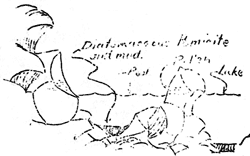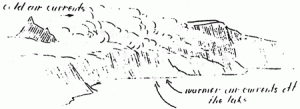The Pools of Wizard Island
By Ranger-Naturalist J. S. Brode
Wizard Island affords a great deal of interesting material for both geological and biological reflection. Many feet tread the trail up the extremely fascinating cinder cone of the island. Relatively few, aside from an occasional fisherman seeking the Skell Channel, tread the rock-piled ramifications of the island to the west of the cone. On this portion of the island erosion has made but little progress. Rough folds of lava rocks have cracked into innumerable jagged blocks of stone that have tumbled into loose jumbled masses. So sharp and angular are the blocks that the whole mass permits the water falling on it to drain readily through it down to the lake level. This same condition permits the waters of the lake to flow through there rock masses at the level of the lake.
As a result of this water table or level, a level fluctuating with the level of the lake, there exist in the hollows between the jagged lava rock piles a number of pools, the size and especially the depth of these pools being determined by the extent to which the collapsed sputter cones developed depressions with a base below the present water level.
On looking at these pools from the Watchman or from the Rim Drive, one observes light green patches which would indicate to the observer the possibility of the existence of beds of algae such as Spirogyra. A visit to the pools, however, reveals a lack of green algae. The patches turn out to be an accumulation of a creamy white mud and ooze. Similar accumulations occur in Skell Channel and between the rocks off the shore of Wizard Island. A carefully examination of samples from a number of these accumulations indicates that they are a highly diatomaceous pumicite sediment.
During the latter part of July the White bark pines (Pinus albicaulis) throw off to the wind a vast amount of pollen. This pollen accumulates in floating bands of yellow which moved about the lake, eventually contacting the shore, where the pollen tended to adhere to the rocks at the shoreline. As the waters of the lake evaporate the pollen is left in rings on the shore rocks. A small amount of the pollen apparently becomes water-logged, or by wave action, gets entangled in the diatomaceous slime on the rocks as a microscopic examination of the rock scrapings indicates their occasional presence. Samples two or three feet down do not show the presence of pollen, hence the reasonable conclusion that the coloration in the shallow portions of the lake is the result of diatomaceous ooze or slime mingled with pumice dust.
Crater Oddities Geese Rest on Crater Lake
By Ranger Dwight A. French
On the last day of August a great flock of geese was observed on the surface of Crater Lake. The next morning they resumed their flight south. The geese were Canadian Honkers which migrate with the changes in seasons. This particular species breed and hatch their young in northern Canada each summer and when the weather gets cold in the fall they migrate to a warmer clime.
Water fowl never stay long on Crater Lake because there is a lack of adequate food and their presence here occurs either in early fall or spring. When geese start south in August and early September old timers shake their heads and predict an early and hard winter.
Crater Oddities: A Warning
By Ranger John S. Day
“Wa’ll, she’s goin’ to be a hard winter,” mused old Sour Dough Pete, as he squinted a pair of pale blue, watery eyes towards the sky. “See them thar Honkers, wall, they’re way head of schedule”.
And sure enough, far up in the blue, the old familiar wedge-shaped line was moving silently southward. Now and then an eerie call would drift down to us, but for the most part they winged quietly and relentlessly on their way toward warmer climes.
The great Canadian Gray Geese migrate with the seasons, going north in the spring and south in the fall; and they are expected visitors over the park during April and October. But why should they be moving south in September? For several days, now, flock after flock of the great Honkers have been passing over; some flying so low that they have to climb higher when going over the Cascade Divide, and other so high that they are barely visible.
Maybe the infallible instinct which graces all wild life has told of early storms and cold weather in the north, and they have followed Nature’s warning by migrating early. Probably old Sour Dough Pete was right when he prophesied a hard winter.
Crater Oddities: A Fading Cloud
By Ranger-Naturalist A. E. Long
Despite the uninviting appearance of the tumbling cloud mass about the summit of the Watchman the evening of August 19 a few hardy or perhaps stubborn individuals with tightly buttoned coats ascended the slopes to the viewpoint station. Arriving on top they found themselves to be above a jumbled blanket of clouds instead of among them. On the right were the topmost crags of Hillman Peak, Llao Rock, Mt. Bailey, Mt. Thielsen and Diamond Peak; to the left all the peaks were covered but behind them the lake remained clear of clouds.
One of the most striking features of the many beautiful cloud structures was the mass between Hillman Peak and Llao Rock. Here a great blanket of clouds seemed about to pour into the crater and yet, though it moved rapidly toward the lake, the lakeward portion of the cloud mass disappeared as quickly as it drifted over the brink of the rim.
The cloud blanket was in a colder mass of swiftly moving air but when it reached the rim to pour over into the lakeward side warmer currents of air streaming up from the lake absorbed the water vapor and therefore the cloud seemed to be evaporating. Warmer air can hold, in an invisible state, more water vapor than can colder air, hence the disappearance of the cloud masses as they drifted across the rim.



